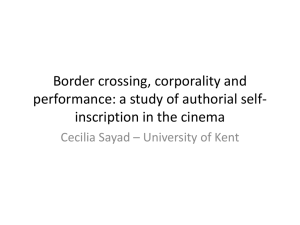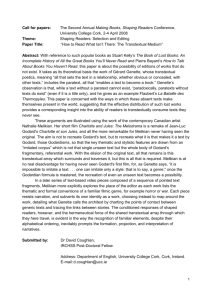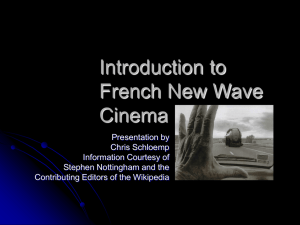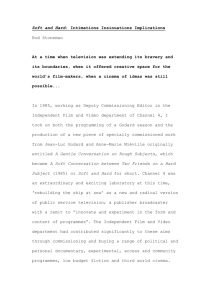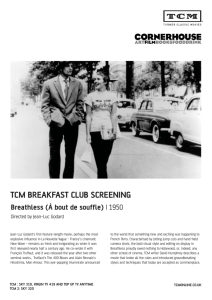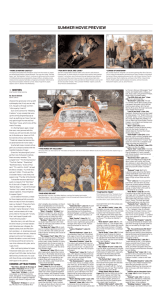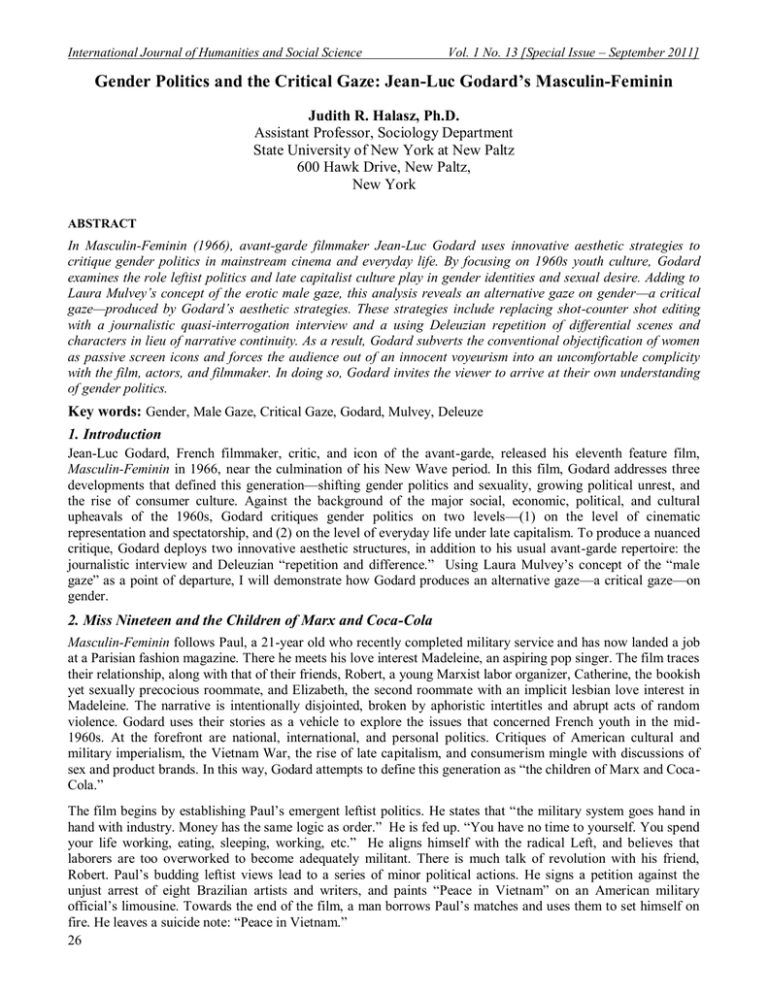
International Journal of Humanities and Social Science
Vol. 1 No. 13 [Special Issue – September 2011]
Gender Politics and the Critical Gaze: Jean-Luc Godard’s Masculin-Feminin
Judith R. Halasz, Ph.D.
Assistant Professor, Sociology Department
State University of New York at New Paltz
600 Hawk Drive, New Paltz,
New York
ABSTRACT
In Masculin-Feminin (1966), avant-garde filmmaker Jean-Luc Godard uses innovative aesthetic strategies to
critique gender politics in mainstream cinema and everyday life. By focusing on 1960s youth culture, Godard
examines the role leftist politics and late capitalist culture play in gender identities and sexual desire. Adding to
Laura Mulvey’s concept of the erotic male gaze, this analysis reveals an alternative gaze on gender—a critical
gaze—produced by Godard’s aesthetic strategies. These strategies include replacing shot-counter shot editing
with a journalistic quasi-interrogation interview and a using Deleuzian repetition of differential scenes and
characters in lieu of narrative continuity. As a result, Godard subverts the conventional objectification of women
as passive screen icons and forces the audience out of an innocent voyeurism into an uncomfortable complicity
with the film, actors, and filmmaker. In doing so, Godard invites the viewer to arrive at their own understanding
of gender politics.
Key words: Gender, Male Gaze, Critical Gaze, Godard, Mulvey, Deleuze
1. Introduction
Jean-Luc Godard, French filmmaker, critic, and icon of the avant-garde, released his eleventh feature film,
Masculin-Feminin in 1966, near the culmination of his New Wave period. In this film, Godard addresses three
developments that defined this generation—shifting gender politics and sexuality, growing political unrest, and
the rise of consumer culture. Against the background of the major social, economic, political, and cultural
upheavals of the 1960s, Godard critiques gender politics on two levels—(1) on the level of cinematic
representation and spectatorship, and (2) on the level of everyday life under late capitalism. To produce a nuanced
critique, Godard deploys two innovative aesthetic structures, in addition to his usual avant-garde repertoire: the
journalistic interview and Deleuzian ―repetition and difference.‖ Using Laura Mulvey‘s concept of the ―male
gaze‖ as a point of departure, I will demonstrate how Godard produces an alternative gaze—a critical gaze—on
gender.
2. Miss Nineteen and the Children of Marx and Coca-Cola
Masculin-Feminin follows Paul, a 21-year old who recently completed military service and has now landed a job
at a Parisian fashion magazine. There he meets his love interest Madeleine, an aspiring pop singer. The film traces
their relationship, along with that of their friends, Robert, a young Marxist labor organizer, Catherine, the bookish
yet sexually precocious roommate, and Elizabeth, the second roommate with an implicit lesbian love interest in
Madeleine. The narrative is intentionally disjointed, broken by aphoristic intertitles and abrupt acts of random
violence. Godard uses their stories as a vehicle to explore the issues that concerned French youth in the mid1960s. At the forefront are national, international, and personal politics. Critiques of American cultural and
military imperialism, the Vietnam War, the rise of late capitalism, and consumerism mingle with discussions of
sex and product brands. In this way, Godard attempts to define this generation as ―the children of Marx and CocaCola.‖
The film begins by establishing Paul‘s emergent leftist politics. He states that ―the military system goes hand in
hand with industry. Money has the same logic as order.‖ He is fed up. ―You have no time to yourself. You spend
your life working, eating, sleeping, working, etc.‖ He aligns himself with the radical Left, and believes that
laborers are too overworked to become adequately militant. There is much talk of revolution with his friend,
Robert. Paul‘s budding leftist views lead to a series of minor political actions. He signs a petition against the
unjust arrest of eight Brazilian artists and writers, and paints ―Peace in Vietnam‖ on an American military
official‘s limousine. Towards the end of the film, a man borrows Paul‘s matches and uses them to set himself on
fire. He leaves a suicide note: ―Peace in Vietnam.‖
26
The Special Issue on Social Science Research
© Centre for Promoting Ideas, USA
www.ijhssnet.com
Powerful protests like this act of self-immolation reduce Paul‘s actions in relation to the uncompromising political
activism of the time. Still he vociferously expresses his political opinions, wondering out loud, how it could be
that if you ―kill a man…you‘re a murderer‖ but if you ―kill thousands…you‘re a conqueror.‖ We witness Paul‘s
radicalization as he increasingly opposes imperialism, sides with the labor movement and embraces socialism.
Godard uses Paul and his friend Robert to stand in for the sons of Marx. Their politicization tempers the intensity
of consumer desires, ever present in the film; however, libido becomes their foil.
Paul feels compelled to confront capitalism as much as imperialism. He begins at his workplace. In a scene
entitled ―Dialogue with a Consumer Product,‖ Paul interviews Miss Nineteen, the winner of a beauty contest
sponsored by the fashion magazine where he and Madeleine work. Paul‘s questions highlight Miss Nineteen‘s
rapture with consumer culture and her unawareness of current political issues. When asked about socialism, she
demurs. ―I can‘t handle such a question. I get confused.‖ With a little prompting she offers that compared to
socialism, the American way of life is ―terrific‖ because it is fast, people seem important, and women have a say
in matters. Paul immediately follows up by asking, ―Does the word ‗reactionary‘ mean anything to you?‖ She
thinks it means ―someone who reacts‖ and concludes that she likes reactionaries. Paul continues, ―Does the
Popular Front mean anything?‖ She is flustered by the question. He switches to issues of sexuality and feminism.
Here she seems a little savvier. She knows about birth control pills and even has to explain to Paul what a
diaphragm is. Now that she‘s traveled and enjoyed some fame, she wants to pursue a career. She also wants to
delay having children, because they‘ll limit her independence. Just when her mild feminism seems to have
restored her character, Paul returns to the political questioning. He ends the interview by asking her if she knows
where in the world there are ongoing wars. She does not. The year is 1965. Unaware of and uninterested in
current political events, Miss Nineteen becomes an icon of empty beauty.
By shooting the six and a half minute scene in a single long-take, with no camera movement, not even a zoom,
Godard puts Miss Nineteen under the unwavering scrutiny of the camera. She is a captive of the frame, forced to
answer embarrassing questions, visibly discomfited by the constant unforgiving gaze of Paul, the camera, and the
audience. There is no lace to mask her imperfections, there is no Hollywood Golden Age glamour lighting to
enhance her allure. With the plain, everyday background of a grey Parisian cityscape seen through an unadorned
window, she is left to fend for herself. At best she has her smile and her mildly liberated womanhood to protect
her from the piercing questions, from the unwavering gaze; even then, her grin and feminism seem to fail her.
Women‘s sexual liberation with the advent of effective, accessible birth control and the relaxation of sexual
morals is generally heralded throughout the film. However, Godard frames women‘s increased participation in the
workforce as promoting consumerism not feminism. The only real weapon Miss Nineteen possesses–her voice–is
regularly undermined, as she is forced to contend with the sounds of the city and the untimely giggles of the girls
in the next room.
Prompting Miss Nineteen with provocative questions, Paul directs the flow of the scene from off-screen. We
never see him, only his voice is present. The camera‘s gaze focuses the critical attention on Miss Nineteen. She
cannot evade the camera, Paul, or the audience. The audience, too, is captive—we cannot look at anything but her.
This intensifies the emotional climate of the scene, the interview as interrogation. The questions are unrelenting
and aggressive, politically and sexually. What does she think of the Vietnam War? Birth control pills? Premarital
sex? The camera exposes Miss Nineteen as a consummate consumer and a product of consumer society, her
every gesture, her appearance, her concerns manufactured. This scene captures the way Godard reproduces and
then eviscerates Hollywood conventions of the cinematic representation of the female icon. He transfigures the
effect of the image of the woman on screen, producing an alternative to the conventions Laura Mulvey identifies
in her seminal essay ―Visual Pleasure and Narrative Cinema‖ (1989). According to Mulvey,
woman ... stands in patriarchal culture as a signifier for the male other, bound by a symbolic order in
which man can live out his fantasies and obsessions through linguistic command by imposing them on
the silent image of woman still tied to her place as bearer, not maker, of meaning. (1989, p.15)
Using semiotics and psychoanalytic theory, Mulvey argues that classical Hollywood cinematic practice places
women on the screen for the benefit of the ―male gaze.‖ The implied male viewer seeks erotic pleasure in the
image of the beautiful woman. Her image holds the male gaze captive; however, any threat her agency may pose
(as Other, as phallic lack, as symbol of castration) is disarmed by an imposed silence—she says little or nothing of
consequence.
27
International Journal of Humanities and Social Science
Vol. 1 No. 13 [Special Issue – September 2011]
On one level, Godard fulfills the desire of the erotic male gaze with this beautiful young woman whose
immobility makes her increasingly flat and iconic. In this way, he satisfies the voyeuristic desire of the audience
and Paul. However, unlike the Hollywood siren, Miss Nineteen is not at all the silent image of feminine beauty.
Godard returns the voice to the woman‘s image—he wants her to be beautiful, sexually attractive, and political.
But his critical gaze reveals not her substance, but her political and intellectual lack—she is too caught up in
capitalist consumption and too uninterested in the human condition to fulfill Godard or Paul‘s desire. She is the
daughter of Coca-Cola, not Marx.
According to Constance Penley (1989a), Godard‘s unorthodox interview format forces the audience into an
uneasy identification, or at least complicity, with the interviewer. Watching from the same position, the audience
is collapsed with the interviewer, who is ever absent from the frame.
We are not given the usual choreography of shot/reverse-shot and the ―reaction shot,‖ as we never see
the interviewer. This arrangement effectively implicates the viewer in the scene far more than having us
look on and overhear the interviewer from a position outside it. We share the imaginary off-screen space
of the interviewer and this is a distinctly uncomfortable place in which to be. (Penley, 1989a, p.109)
The woman is captured, deconstructed, flattened by Godard and his audience‘s gaze. The viewer, in the place of
the interviewer, is now aggressively probing into her desires. Because Paul/Godard frames the questions within a
Marxist perspective, Miss Nineteen‘s responses disappoint. While there is still pleasure in the image of the
woman, it is tempered by the uncomfortable assault the viewer is lead along. According to Penley, the way
Godard reveals insight into the social development of gender compromises the sharpness of this insight. ―Godard
has never adopted the common political film strategy of letting the oppressed speak directly, ‗in their own
words‘‖ (Penley, 1989a, p.111). Godard uses the interview in lieu of shot-counter shot editing as the dominant
aesthetic strategy throughout Masculin-Feminin. In every instance, the interviewee is subjected to the
overwhelming flow of the interrogation. In the interview with Miss Nineteen, there are no breaks, no disruptions,
no shifts in the positions of the interviewer and the interviewee. And, unable to redirect the flow of the dialogue,
Miss Nineteen is, for the most part, at the mercy of Paul/Godard.
3. Deleuzian Repetition and Difference
To structure Masculin-Feminin without reproducing the patriarchal mechanisms Mulvey and other feminist critics
identify in film, Godard uses what Gilles Deleuze (1968) conceptualizes as repetition and difference, adding more
layers, more complexity to his criticisms of and insights into gender. He repeats entire scenes, using different
characters but similar mise-en-scene and dialogue cues to illicit varied responses. Godard‘s repetition adds
differential layers or paths of flight from the same point. Each scenario engenders countless possibilities; these
possibilities constitute the depth of social reality. By showing multiple developments from a given starting point,
Godard snatches from the viewer the easy linearity of conventional narratives. In doing so, Godard replaces the
psychological depth of character typically produced by narrative continuity with multiple representations of
character-types, in this case the political boy on the make and the superficial girl teasing the boys sexually. As a
result, the audience struggles to feel empathy for or identify with the characters—for they are each variations on a
theme exposing each other‘s flaws. Paul is just a slightly more sensitive version of the doctrinaire Robert. Both
see women‘s breasts before their personality or political convictions. And while Madeleine and Miss Nineteen are
notably superficial, Catherine‘s appreciation of classical music and poetry seems little more than a ploy to win
Paul away from Madeleine. No longer lead by the hand along a singular narrative path, the spectator is confronted
by different possible trajectories for a given scene, and left to their own devices to locate the logic and meaning.
Not only must the viewer make sense out of the repetition, they cannot neglect the complexity difference
indicates.
In Cinema 2: The Time-Image, Deleuze describes such a structuring of film as ―the whole is the outside‖ (1989,
p.179). In contrast to the imposed narrative linearity and continuity editing of classical cinema, modern film
operates not by the association of images, but by their differentiation. The effect of the film derives from the
interstices between the images, rather than the images themselves.
Given one potential, another one has to be chosen, not any whatever, but in such a way that a
difference of potential is established between the two, which will be productive of a third or of
something new. … It is not a matter of following a chain of images, even across voids, but of
getting out of the chain or the association. (Deleuze, 1989, p.179–80)
28
The Special Issue on Social Science Research
© Centre for Promoting Ideas, USA
www.ijhssnet.com
These ―unlinked‖ images are presented not as part of a unified whole, but as categories in a series.
Each series refers to a way of seeing or speaking, for its own purposes, a way which may be that of
current opinion operating though slogans, but equally that of a class, a sort, a typical character operating
through thesis, hypothesis, paradox or even pretended cleverness, abrupt change of subject. Each series
will be the way in which the author expresses himself indirectly in a sequence of images attributable to
another, or, conversely, the way in which something or someone is expressed indirectly in the vision of
the author considered as other. In any case, there is no longer the unity of the author, the characters and
the world such as was guaranteed by the internal monologue. (Deleuze, 1989, p.183)
The spectator is not summoned to identify with one or several characters, or to escape into the fantasy world of
the movie, but to take the multitude of character types—categories in a series—and make meaning outside the
illusionistic world of cinematic images, based on intertextuality, not ensconcement nor suture. In other words, the
spectator is beckoned to reflect on the incommensurability of the images and categories.
While the individual characters are at times opaque and categorical, the layering through repetition and difference
creates a complexity that comes across as human. Godard does not rely on psychological realism and depth.
Instead, he creates sociological depth by concentrating more on what happens between characters than inside
them. By repeating interactions between different sets of characters, the multiple sociological types coalesce into
a nuanced portrayal of masculinities and femininities. In this way Godard brings pathos to an otherwise biting
critique of conventional gender identities. Consider the parallel courting scenes between Paul and Madeleine as
compared to Robert and Catherine. Early in the film when Paul first invites Madeleine out on a date, she asks him
if he has ever had sex with a prostitute. He responds in the affirmative, but adds that he does not like them
because they are ―sad and cold.‖ In a later scene, where the Marxist laborer Robert asks Catherine out on a date,
she poses the same question. Again the response is yes. Only this time, Robert adds that he sleeps with prostitutes
not out of a lack of a girlfriend, but because he likes prostitutes and ―the sort of things they do,‖ at which point
Catherine rejects his invitation. With the repetition of differential scenes, the audience recognizes that the mating
dance has a certain rhythm, a certain choreography, which is successful if performed with grace, but the slightest
misstep could prematurely cut off the possibilities. The politics of gender and sexuality are made visible by the
juxtaposition of such parallel scenes.
It is important to recognize that Godard does not focus his critical gaze on women alone. When Paul first courts
Madeleine, the two engage in an interview reminiscent of the ―Dialogue with a Consumer Product.‖ Only in this
version, male and female alternate as the off-screen interviewer and the looked-at interviewee, challenging the
male gaze. The shot focuses on one character through several dialogue exchanges before cutting to the other,
producing uncomfortable yet naturalistic and even revelatory silences. The off-screen interviewer directing the
flow of the dialogue dominates the looked-at other with their questions. When Madeleine is at the helm, she first
asks Paul why he is pursuing her. He explains that she is pretty and has a certain ―tenderness,‖ to which she coyly
responds ―there‘s nothing else you like about me?‖ He can only elaborate by talking about her looks in more
detail. He sees in her exactly what she emphasizes in herself—her physical appearance. Her success becomes her
failure. She has achieved the height of a certain feminine ideal—physical beauty, allure, fashionability. But she
seems to want him to see something deeper to give more meaning to his desire than libido alone. She pointedly
asks, ―By going out, do you mean going to bed?‖ He cannot respond; still, the camera will not release him from
the question that bares his intentions. ―Tell me honestly,‖ she implores.
Still no response. ―Tell me.‖ Neither she nor the camera will let him off the hook so easily. He looks down, grabs
a cigarette from his jacket pocket, smiles as he looks up, and flips the cigarette into his mouth. His silence
answers the question. It would be uncouth to admit his intentions, but he does not want to lie. It is apparent that
Madeleine now has the power to keep him captive with this interrogation, with this critical gaze, or release him
from his unease. She relents and changes her tactic, asking about his background, family, and dating habits. Only
when he asserts himself and boldly announces his libidinous intentions does the camera release him from scrutiny.
As Madeleine is asking the questions, Paul experiences an uncomfortable captivity similar to that of Miss
Nineteen. The critical gaze turns on him, and the limits of his political sensibility are revealed. Despite Paul‘s
leftist politics, his sexual politics are not so radical. Obviously motivated by his libido and an attraction to
Madeleine‘s superficial traits, he goes as far as to tell her that her breasts are the type he likes. In this light, Paul‘s
obsession with politics appears superficial, as much a concession to popular culture as Madeleine‘s obsession
with products and appearance.
29
International Journal of Humanities and Social Science
Vol. 1 No. 13 [Special Issue – September 2011]
In the parallel courting scene, Robert, the doctrinaire Marxist laborer, ineptly attempts to woo the bookish
Catherine. This time the critical gaze is directed almost entirely at his machismo and crudeness. Robert
rationalizes his poor manners and inability to express himself confidently around women by claiming that the
government prevents workers from attending college and becoming properly educated. From earlier scenes, we
know that Robert has little difficulty discussing politics at length with Paul. Thus Robert‘s ineloquence more
likely stems from his romantic inexperience and anxious libido. For him, women are objects of sexual desire, not
intellectual or political equals. The camera dissects Robert‘s blatant misogyny with a critical gaze as harsh as that
unleashed upon Miss Nineteen. Radical politics concerning the State and labor provide no cover for Robert‘s
conservative attitude towards gender and sexuality. Godard uses Paul and Robert to expose the sexism that lurked
in the radical social movements of the 1960s—the young Marxist men in the film not only succumb to their
libidinal desires, but relegate women to the libidinal sphere. Through such repetition and difference, Godard
exposes masculinity and femininity with his critical gaze.
4. Godard’s Critical Gaze on Gender Politics
The critical gaze is the mode of spectatorship Godard‘s avant-garde cinema conditions. In what sense is this gaze
critical? First, it serves the function of critique. The critical gaze foregrounds certain ideological structures—in
this film, patriarchy, consumerism, and political apathy—and demonstrates their interconnectedness. Godard
invites the viewer to critically engage with what they see, both in form and content. Phenomenologically, this
promotes a more intellectual, attuned viewing experience, intentionally disrupting fluid semi-conscious
spectatorship.1 Second, the critical gaze induces dialectical spectatorship, in that it keeps pleasure and displeasure
simultaneously in play. In a reflexive moment, this returns our gaze back onto ourselves. Viewing the object
compels us to acknowledge how our subjectivity (our viewing position, our role in the objectification of the
woman image) is predicated on object relations (not necessarily in the psychoanalytic sense). Subject and object
are constantly playing off each other. This produces an active engagement with the text and makes spectatorship a
more reflexive, self-conscious activity.
The concept of the critical gaze complements Brian Henderson (1999), Peter Wollen (1999), Deleuze (1968,
1989), and Colin MacCabe‘s (1976) assessments of Godard‘s non-classical aesthetic. Hollywood film, both as an
industry and an aesthetic, is situated within capitalist structures and culture. 2 By subverting and at times rejecting
Hollywood conventions, Godard attempts not simply to produce an alternative to mainstream cinema, but to
produce one that (1) demonstrates mainstream cinema‘s implication in capitalist and conservative ideological
structures, and (2) does not reproduce those very indexical structures in its form. Henderson, Wollen, and Deleuze
argue that Godard‘s avant-garde films produce reflexivity in spectatorship, through non-linear narratives, noncontinuity editing, and lack of psychological depth of character, among other strategies. This reflexivity tends to
undermine given ideological structures by rupturing assumed linkages. In the place of flow and continuity,
Godard offers incommensurables, which must be made sense of, and in the process questioned, scrutinized, and
criticized.
The dislocation between [contradictory elements] focuses attention on the position of the spectator—
both in the cinema and politically. These juxtapositions make the spectator constantly aware of the
discourses that confront him as discourses—as, that is, the production of sets of positions—rather than
allowing him to ignore the process of articulation by entering a world of correspondence in which the
only activity required is to match one discourse against the realm of truth. (MacCabe, 1976, p.183)
The spectator is no longer Mulvey‘s pleasured male voyeur. Instead, we become the critic—like Godard—of film
and society.3 We watch from a psychologically disengaged distance. We are not sutured into the film, we do not
identify easily with the characters. No, we watch from a critical distance. From this vantage point, we can analyze
the totality, in this case the social system in which consumerism penetrates youth culture and challenges political
engagement, which together condition gender politics. We focus alternately on the image itself and the way that it
supports this totality. Attunement to these discourses makes our gaze all the more critical.
On the one hand Godard takes a situation recognizable through our own direct experience of life,
dilemmas within society, similar to and familiar from the real world. On the other, he examines the
cinematic image in order to demonstrate how far that direct experience is already an experience of
images. This film‘s foregrounding of its own process of production and its break with the conventions of
verisimilitude are not at the service of a formalist aesthetic. They allow Godard to confront the way that
consumer society mold woman‘s image so that it conforms to a given concept of female sexual appeal. ...
30
The Special Issue on Social Science Research
© Centre for Promoting Ideas, USA
www.ijhssnet.com
The female body has become industrialized; a woman must buy the means to paint on (make-up) and
sculpt (underwear/clothes) a look of femininity, a look which is the guarantee of visibility in sexist
society for each individual woman. (Mulvey and MacCabe, 1989, p.54)
As Mulvey and MacCabe suggest, Godard‘s critical gaze confronts not only stereotypical assumptions about
gender, but also the taken-for-granted use of gendered images in film. Godard exaggerates the emptiness of the
women to illustrate the construction of the male gaze. In this way, Godard performs a double-intervention: in the
order of the film and in the order of the lived world. We take pleasure in seeing Madeleine and Miss Nineteen
pout for the camera, nevertheless we become uncomfortably aware of our own complicity in this pleasure.
Mulvey acknowledges that Godard presents a challenge to the male gaze. She explains,
The first blow against the monolithic accumulation of traditional film conventions (already
undertaken by radical film-makers) is to free the look of the camera into its materiality in time and
space and the look of the audience into dialectics and passionate detachment. There is no doubt
that this destroys the satisfaction, pleasure and privilege of the ‗invisible guest‘, and highlights
how film has depended on voyeuristic active/passive mechanisms. (Mulvey, 1989, p.26)
On the level of spectacle, Godard‘s close-ups and extended shots of beautiful women fulfill the libidinous
voyeuristic desire Mulvey identifies in film. And yet he undermines just that pleasure, with a critical gaze. He
forces the audience to confront the desire embedded in their spectatorship. By showing the young men and
women to be superficial, though not altogether unsympathetic, Godard reveals the compromises involved in the
fulfillment of such desire, actual and mediated. Godard is attempting to create a cinematic illumination of the
dialectics of gender and desire. He does this, in large part, by undermining the film conventions that feed into the
ideological order of the patriarchy. The very camera technique, the mediated gaze, which is intended to fulfill our
desire, is used to rescind that fulfillment, by lingering too long, by allowing space and time to reveal the
construction lines of gender and sexuality, by reminding us we are voyeurs.
It should be noted that several influential feminist film scholars, including Molly Haskell (1973), Penley (1989a,
1989b) and Mulvey (with MacCabe, 1989) have accused Godard of objectifying and exploiting women in his
films. For example, in their critique of Godard‘s cinematic gender politics, Mulvey and MacCabe question
whether the use of an image of a naked woman is inherently complicit with the exploitation of the female as
silenced sexual body, as object of the male gaze.
For many, the use of a naked female body immediately casts doubt on Godard‘s project. The very image
for the most visible exploitation that women endure in a sexist society cannot be used with impunity,
cannot be used without a certain complicity. Once again, the position is not straightforward. It is possible
to argue that Godard‘s use of the image of the body is resolutely unexploitative. The length of the shots
and the fact that the image of the body is not presented as spectacle makes us uneasy in our position of the
voyeur. If we look at this woman‘s body then we are aware of our own look, which is not hidden in the
folds of the narrative and the movement of the camera. Similarly there is none of that titillation of vision
on which exploitation depends. What we see is not the product of an unveiling, we gaze at a female body
for several minutes. But although these arguments are valid they do not resolve the problem. The shot of
the naked woman is a good example. On the one hand its length and form are an attempt to demystify the
very source of our images of women and yet, at the same time, the potency of that image is such that it is
doubtful that any simple demystification is possible. (Mulvey and MacCabe, 1989, p.52)
While there is little nudity in Masculin-Feminin, the way that Godard uses the image of the female face and body
is problematic similar to the way Mulvey and MacCabe suggest. Godard may illustrate and deconstruct the
cinematic exploitation of the female as object; however, he does so through exaggeration, which runs the risk of
complicity. The very interview style that constitutes a critical gaze also allows Godard to linger on the faces of
Madeleine and Miss Nineteen, especially through their silences. While their hollow beauty and self-absorption
may point to the way that mainstream films, not to mention modern consumer culture, foreclose on the depth and
agency of women, their beauty is real, and thus produces the very visual pleasure of the erotic gaze that Mulvey
describes. Nevertheless, I would argue that Godard‘s use of the image of the woman in Masculin-Feminin is
ultimately non-objectifying. Godard‘s sociological insights into the mutually conditioning relationship between
capitalism and gender are revelatory and potentially liberating. Even Mulvey concedes this point.
31
International Journal of Humanities and Social Science
Vol. 1 No. 13 [Special Issue – September 2011]
Women‘s contribution to the modern world can be measured according to their sex appeal. This is a
point that Godard returns to repeatedly in his films. He understands the forces that mold women into a
stereotype and reduce them to impotence. ... More than any other single film-maker Godard has shown
up the exploitation of woman as an image in consumer society. (Mulvey and MacCabe, 1989, p.50)
Godard uses the image of woman with an awareness of all its effects, and he makes these effects, not the woman,
his subject. This allows the viewer to engage in a critical understanding of gender and sexuality, an understanding
that accounts for normative pressures to conform to gender conventions, while recognizing them as such. Mulvey
suggests that the image of woman on screen has an innate erotic force. Yet, this erotic component does not nullify
the critical gaze. In fact, the tension between Madeleine‘s beauty and her emptiness challenges the viewer to
maintain a critical stance towards her and the other women in the film—one aspect draws the audience in, the
other repels. The audience experiences the pleasure of the erotic gaze; at the same time, they are confronted by the
objectification inherent in such pleasure. The power of Godard‘s critique lies in how he allows the viewer to
arrive at their own awareness of the problematic use and construction of gender in film, and carry that awareness
into the whole that is outside the film.
NOTES
1.
2.
3.
For more on the phenomenology of spectatorship, see for example Hugo Munsterberg‘s The Film: A Psychological
Study, J.L. Baudry‘s ―Ideological Effects of the Basic Cinematographic Apparatus,‖ or Carl Plantinga‘s Moving Viewers:
American Film and the Spectator’s Experience.
For a discussion of classical cinema‘s relationship to capitalism in particular and ideological structures in general, see the
work published in the Cahiers du Cinema. See for example, the Cahier du Cinema Editorial Board‘s ―Young Mr.
Lincoln, texte collectif,‖ J.L. Comolli‘s ―La profondeur de champ ‗primitive,‘‖ or his ―II. Profondeur de champ: la
double scene (suite): (Notes pour une histoire materialiste…suite).‖
Wollen (1972) notes that Godard uses narrative intransitivity among other techniques to engage the viewer as a critic.
REFERENCES
Baudry, J.L. (1974–1975). Ideological Effects of the Basic Cinematographic Apparatus. Film Quarterly, 28(2), 39–47.
Cahier du Cinema Editorial Board. (1972). John Ford‘s Young Mr. Lincoln. Screen, 13, 5–44. Originally published in
Cahiers du Cinema, 223 (1970).
Comolli, J.L. (1971a). II. Profondeur de champ: la double scene (suite): (Notes pour une histoire materialiste…suite).
Cahiers du Cinema, 231, 42–49.
Comolli, J.L. (1971b). La profondeur de champ ―primitive.‖ Cahiers du Cinema, 233, 40–45.
Deleuze, G. (1989). Cinema 2: The Time-Image, trans. Hugh Tomlinson and Robert Galeta, Minneapolis, MN:
University of Minnesota Press.
Deleuze, G. (1968). Différence et répétition. Paris, France: PUF.
Haskell, M. (1973). From Reverence to Rape: The Treatment of Women in the Movies. New York, NY: Holt, Rinehart
and Winston.
Henderson, B. (1999). Towards a Non-Bourgeois Camera Style. In L. Braudy and M. Cohen (Eds.), Film Theory and
Criticism (pp. 57–67). New York, NY: Oxford University Press.
MacCabe, C. (1986). Theory and Film: Principles of Realism and Pleasure. In P. Rosen (Ed.), Narrative, Apparatus,
Ideology (pp. 179–197). New York, NY: Columbia University Press. Originally published in Screen, 17(3) (1976).
Mulvey, L. (1989). Visual Pleasure and Narrative Cinema. In Visual and Other Pleasures (pp. 14–26). Bloomington,
IN: Indiana University Press.
Mulvey, L. and MacCabe, C. (1989). Images of Women, Images of Sexuality: Some Films by J. L. Godard. In Visual
and Other Pleasures (pp. 49–62). Bloomington, IN: Indiana University Press.
Munsterberg, H. (1970). The Film: A Psychological Study. New York, NY: Dover Publications.
Penley, C. (1989a). Les Enfants de la Patrie (on France/Tour/Detour/Two Children). In The Future of an Illusion: Film,
Feminism, and Psychoanalysis (pp. 93–118). Minneapolis, MN: University of Minnesota Press.
Penley, C. (1989b). Pornography, Eroticism (on Every Man for Himself). In The Future of an Illusion: Film, Feminism,
and Psychoanalysis (pp. 83–90). Minneapolis, MN: University of Minnesota Press.
Plantinga, C. (2009). Moving Viewers: American Film and the Spectator’s Experience. Berkeley, CA: University of
California Press.
Wollen, P. (1999). Godard and Counter Cinema: Vent D’Est. In L. Braudy and M. Cohen (Eds.), Film Theory and
Criticism (pp. 499–507). New York, NY: Oxford University Press.
32

